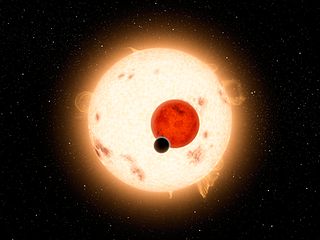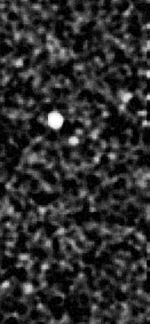
A Super-Earth or super-terran or super-tellurian is a type of exoplanet with a mass higher than Earth, but substantially below those of the Solar System's ice giants, Uranus and Neptune, which are 14.5 and 17.1 times Earth's, respectively. The term "super-Earth" refers only to the mass of the planet, and so does not imply anything about the surface conditions or habitability. The alternative term "gas dwarfs" may be more accurate for those at the higher end of the mass scale, although "mini-Neptunes" is a more common term.

An exoplanet is a planet located outside the Solar System. The first evidence of an exoplanet was noted as early as 1917, but was not recognized as such until 2016; no planet discovery has yet come from that evidence. What turned out to be the first detection of an exoplanet was published among a list of possible candidates in 1988, though not confirmed until 2003. The first confirmed detection came in 1992, with the discovery of terrestrial-mass planets orbiting the pulsar PSR B1257+12. The first confirmation of an exoplanet orbiting a main-sequence star was made in 1995, when a giant planet was found in a four-day orbit around the nearby star 51 Pegasi. Some exoplanets have been imaged directly by telescopes, but the vast majority have been detected through indirect methods, such as the transit method and the radial-velocity method. As of 24 July 2024, there are 7,026 confirmed exoplanets in 4,949 planetary systems, with 1007 systems having more than one planet. This is a list of the most notable discoveries.

Kepler-16b is a Saturn-mass exoplanet consisting of half gas and half rock and ice. It orbits a binary star, Kepler-16, with a period of 229 days. "[It] is the first confirmed, unambiguous example of a circumbinary planet – a planet orbiting not one, but two stars," said Josh Carter of the Center for Astrophysics | Harvard & Smithsonian, one of the discovery team.

Kepler-69c is a confirmed super-Earth exoplanet, likely rocky, orbiting the Sun-like star Kepler-69, the outermore of two such planets discovered by NASA's Kepler spacecraft. It is located about 2,430 light-years from Earth.

Kepler-37b is an exoplanet orbiting the star Kepler-37 in the constellation Lyra. As of February 2013, it is the smallest planet discovered around a main-sequence star, with a radius slightly greater than that of the Moon and slightly smaller than that of Mercury. The measurements do not constrain its mass, but masses above a few times that of the Moon give unphysically high densities.

Kepler-62e is a super-Earth exoplanet discovered orbiting within the habitable zone of Kepler-62, the second outermost of five such planets discovered by NASA's Kepler spacecraft. Kepler-62e is located about 990 light-years from Earth in the constellation of Lyra. The exoplanet was found using the transit method, in which the dimming effect that a planet causes as it crosses in front of its star is measured. Kepler-62e may be a terrestrial or ocean-covered planet; it lies in the inner part of its host star's habitable zone.
Kepler-62c is an approximately Mars-sized exoplanet discovered in orbit around the star Kepler-62, the second innermost of five discovered by NASA's Kepler spacecraft around Kepler-62. At the time of discovery it was the second-smallest exoplanet discovered and confirmed by the Kepler spacecraft, after Kepler-37b. It was found using the transit method, in which the dimming that a planet causes as it crosses in front of its star is measured. Its stellar flux is 25 ± 3 times Earth's. It is similar to Mercury.

Kepler-47b is an exoplanet orbiting the binary star system Kepler-47, the innermost of three such planets discovered by NASA's Kepler spacecraft. The system, also involving two other exoplanets, is located about 3,400 light-years away.

Kepler-442b is a confirmed near-Earth-sized exoplanet, likely rocky, orbiting within the habitable zone of the K-type main-sequence star Kepler-442, about 1,196 light-years (367 pc) from Earth in the constellation of Lyra.

K2-3d, also known as EPIC 201367065 d, is a confirmed exoplanet of probable mini-Neptune type orbiting the red dwarf star K2-3, and the outermost of three such planets discovered in the system. It is located 143 light-years away from Earth in the constellation of Leo. The exoplanet was found by using the transit method, in which the dimming effect that a planet causes as it crosses in front of its star is measured. It was the first planet in the Kepler "Second Light" mission to receive the letter "d" designation for a planet. Its discovery was announced in January 2015.

K2-33b is a very young super-Neptune exoplanet, orbiting the pre-main-sequence star K2-33. It was discovered by NASA's Kepler space telescope on its "Second Light" mission. It is located about 453 light-years away from Earth in the constellation of Scorpius. The exoplanet was found by using the transit method, in which the dimming effect that a planet causes as it crosses in front of its star is measured.
K2-72c is a small exoplanet orbiting around the red dwarf star K2-72 approximately 227.7 light-years away. It is located in the inner edge of the habitable zone. K2-72c completes an orbit in 15.2 days, and it has a radius of only 86% of that of the Earth.

K2-72e (also known by its EPIC designation EPIC 206209135.04), is a confirmed exoplanet, likely rocky, orbiting within the habitable zone of the red dwarf star K2-72, the outermost of four such planets discovered in the system by NASA's Kepler spacecraft on its "Second Light" mission. It is located about 217.1 light-years (66.56 parsecs, or nearly 2.0538×1015 km) away from Earth in the constellation of Aquarius. The exoplanet was found by using the transit method, in which the dimming effect that a planet causes as it crosses in front of its star is measured.
K2-141b is a massive rocky exoplanet orbiting extremely close to a K Type orange main-sequence star K2-141. The planet was first discovered by the Kepler space telescope during its K2 “Second Light” mission and later observed by the HARPS-N spectrograph. It is classified as an ultra-short period planet (USP) and is confirmed to be terrestrial in nature. Its high density implies a massive iron core taking up between 30% and 50% of the planet's total mass.
K2-155d is a potentially habitable Super-Earth exoplanet in the K2-155 system. It is the outermost of three known planets orbiting around the K-type star K2-155 in the constellation Taurus, approximately 290 light years from Earth. It is one of 15 new exoplanets around red dwarf stars discovered by Japanese astronomer Teruyuki Hirano of the Tokyo Institute of Technology and his team. The team used data from NASA's Kepler Space Telescope during its extended K2 "Second Light" mission. K2-155d orbits near the so-called habitable zone of its system, and has the potential to host liquid water.

K2-236b is a Neptune-like exoplanet that orbits an F-type star. It is also called EPIC 211945201 b. Its mass is 27 Earths, it takes 19.5 days to complete one orbit of its star, and is 0.148 AU from its star. Its discovery was announced in 2018. This was the first exoplanet discovered by scientists based in India. The discoverers were Abhijit Chakraborty (PRL), Arpita Roy (Caltech), Rishikesh Sharma (PRL), Suvrath Mahadevan, Priyanka Chaturvedi, Neelam J. S. S. V. Prasad (PRL), and B. G. Anandarao (PRL).

K2-288Bb is a super-Earth or mini-Neptune exoplanet orbiting in the habitable zone of K2-288B, a low-mass M-dwarf star in a binary star system in the constellation of Taurus about 226 light-years from Earth. It was discovered by citizen scientists while analysing data from the Kepler space telescope's K2 mission, and was announced on 7 January 2019. K2-288 is the third transiting planet system identified by the Exoplanet Explorers program, after the six planets of K2-138 and the three planets of K2-233.
K2-66b is a confirmed mega-Earth orbiting the subgiant K2-66, about 520 parsecs (1,700 ly) from Earth in the direction of Aquarius. It is an extremely hot and dense planet heavier than Neptune, but with only about half its radius.

TOI-2180 b is a giant exoplanet orbiting the G-type star TOI-2180, also known as HD 238894. It was discovered with the help of the Transiting Exoplanet Survey Satellite and is currently the exoplanet with the longest orbital period TESS was able to uncover. TOI-2180 b orbits its host star every 260.16 days.


















